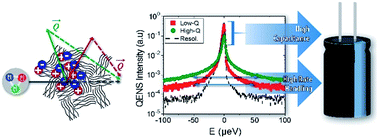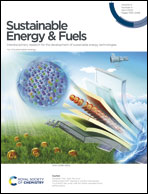Microscopic dynamics in room-temperature ionic liquids confined in materials for supercapacitor applications
Abstract
The performance of electrical double layer capacitors (EDLCs), also known as supercapacitors, which are composed of porous electrodes and ionic liquid electrolytes, depends largely on the structure and dynamics of molecules/ions at the electrode–electrolyte interfaces. Immobilization of ions on the electrode surface and diffusivity of ions in the middle of the pores are two important phenomena influencing the performance of supercapacitors. In recent years, porous carbon or metal carbide derived electrodes and ionic liquid electrolytes, either in the neat state or mixed with organic solvents, were used to improve the energy and power density of supercapacitors. The molecular/ionic level predictive understanding of ion immobilization and movement inside the pores can be achieved, in principle, using molecular dynamics (MD) simulations. This calls for experimental techniques capable of validating MD predictions and providing directions for future MD studies. Neutron scattering techniques, particularly quasi-elastic neutron scattering (QENS), uniquely provide information directly comparable with MD simulation results. This includes electrolytes confined in electrode materials, due to high penetrative power of neutrons and their high sensitivity to hydrogen-bearing species. This paper reviews recent research where QENS, together with electrochemical measurements and molecular dynamics simulations, has been employed to explore complex electrode/electrolyte systems, which is critical for developing predictive understanding of the charge storage mechanism in supercapacitors.



 Please wait while we load your content...
Please wait while we load your content...
